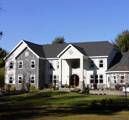
Neoeclectic (1965 – Present)
Recent homes incorporate many styles. Architects and designers call this new stylistic mix Neoeclectic, or Neo-eclectic.
History:
During the late 1960s, a rebellion against modernism and a longing for more traditional styles influenced the design of modest tract housing in North America. Builders began to borrow freely from a variety of historic traditions, offering Neoeclectic (or, Neo-eclectic) houses that were “customized” using a mixture of features selected from construction catalogs. These homes are sometimes called Postmodern because they borrow from a variety of styles without consideration for continuity or context. However, Neoeclectic homes are not usually experimental and do not reflect the artistic vision you would find in a truly original, architect-designed postmodern home.
A Neoeclectic home can be difficult to describe because it combines many styles. The shape of the roof, the design of the windows, and decorative details may be inspired by several different periods and cultures.
Critics use the term McMansion to describe a Neoeclectic home that is over-sized and pretentious. Coined from the McDonald’s fast food restaurant, the name McMansion implies that these homes are hastily assembled using cheaply-made materials and a menu of mix-and-match decorative details.
Features:
Constructed in the 1960s or later
Historic styles imitated using modern materials like vinyl or imitation stone
Details from several historic styles combined
Details from several cultures combined
Brick, stone, vinyl, and composite materials combined
Next: Neo-mediterranean